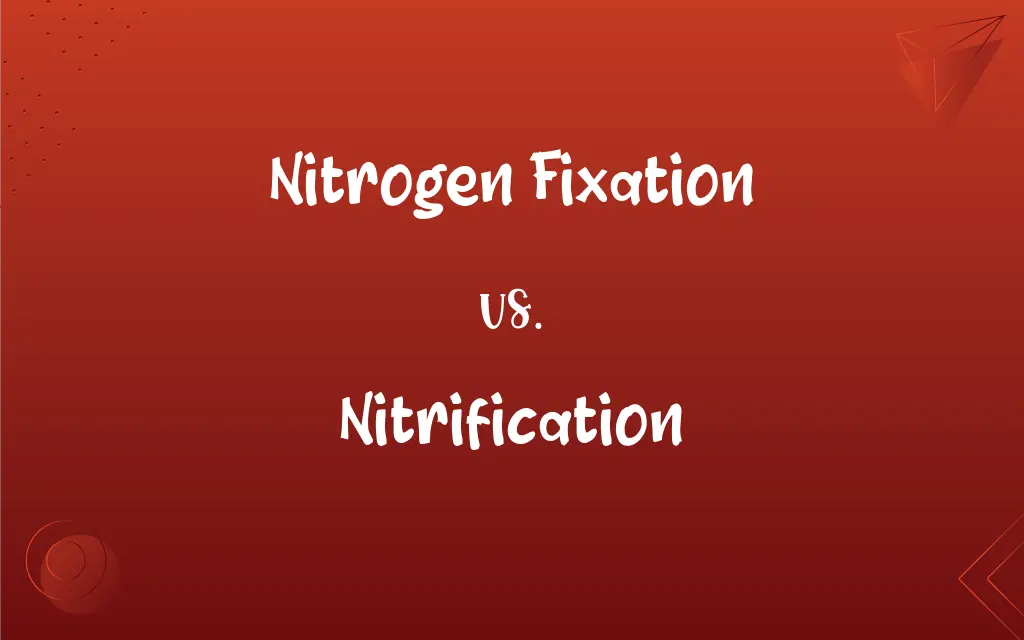Nitrogen Fixation vs. Nitrification: What's the Difference?
Edited by Janet White || By Harlon Moss || Updated on October 28, 2023
Nitrogen fixation is the process of converting atmospheric nitrogen (N₂) into ammonia (NH₃), while nitrification converts ammonia into nitrites and nitrates.

Key Differences
Nitrogen fixation and nitrification are vital processes in the nitrogen cycle, ensuring the conversion and availability of nitrogen for plants and other organisms. While nitrogen fixation refers to the conversion of atmospheric nitrogen (N2) into a usable form by certain bacteria, nitrification is the process by which ammonia is converted into nitrate by other sets of bacteria.
The primary function of nitrogen fixation is to make atmospheric nitrogen accessible to plants. Specific bacteria, like those in the root nodules of legumes or some free-living bacteria in the soil, capture and convert N2 into ammonia (NH3) or related compounds. On the other hand, nitrification acts as a subsequent step, where ammonia, either from fixation or other sources, undergoes a two-step conversion: first to nitrite (NO2-) and then to nitrate (NO3-), primarily by nitrifying bacteria.
While nitrogen fixation is an anaerobic process that requires a lot of energy, often derived from the breakdown of carbohydrates by the bacteria, nitrification is an aerobic process conducted by nitrifying bacteria in the presence of oxygen. These distinctions in conditions mean that nitrogen-fixing bacteria and nitrifying bacteria thrive in different soil environments, with fixation preferring low-oxygen conditions and nitrification demanding well-aerated soils.
Both nitrogen fixation and nitrification have significant agricultural implications. With fixation, crops like beans and peas can acquire nitrogen directly from the atmosphere, reducing the need for nitrogenous fertilizers. Meanwhile, nitrification ensures that nitrogen in the soil is in the form of nitrates, which are more easily taken up by plant roots than ammonia or nitrite.
Comparison Chart
Process
Converts N₂ to NH₃
Converts NH₃ to NO₂⁻ and then to NO₃⁻
ADVERTISEMENT
Main Microbes Involved
Nitrogen-fixing bacteria
Ammonia-oxidizing and nitrite-oxidizing bacteria
Importance in Nitrogen Cycle
Introduces available nitrogen to ecosystems
Transforms ammonia to less harmful nitrates
Occurs in
Root nodules of legumes and some free-living bacteria
Soil and aquatic environments
Associated with
Leguminous plants
Soil nitrates
Nitrogen Fixation and Nitrification Definitions
Nitrogen Fixation
A microbial process of making nitrogen available.
The nitrogen fixation by bacteria helps plants grow.
ADVERTISEMENT
Nitrification
The transformation of toxic ammonia.
After nitrification, plants can easily take up the resulting nitrates.
Nitrogen Fixation
The synthesis of organic nitrogen compounds.
Through nitrogen fixation, some plants can thrive in nitrogen-poor soils.
Nitrification
A two-step microbial oxidation process.
Nitrification in the aquarium filter helps detoxify the water.
Nitrogen Fixation
Introduction of biologically useful nitrogen.
Crop rotation uses legumes for nitrogen fixation to benefit subsequent crops.
Nitrification
A bacterial-driven soil process.
Proper aeration promotes nitrification in wastewater treatment.
Nitrogen Fixation
Conversion of atmospheric nitrogen to ammonia.
Symbiotic bacteria in legume roots aid in nitrogen fixation.
Nitrification
Production of soil nitrates from ammonia.
Nitrification ensures the conversion of harmful ammonia to plant-friendly nitrates.
Nitrogen Fixation
The assimilation of gaseous nitrogen.
Certain bacteria excel at nitrogen fixation from the air.
Nitrification
Conversion of ammonia to nitrites and nitrates.
The soil underwent nitrification, increasing its nitrate content.
Nitrification
To oxidize (an ammonia compound) into a nitrite or (a nitrite) into a nitrate, especially by the action of nitrifying bacteria.
FAQs
Are both nitrogen fixation and nitrification biological processes?
Yes, both are mainly microbial processes.
What microbes drive nitrification?
Ammonia-oxidizing and nitrite-oxidizing bacteria.
How does nitrification relate to the nitrogen cycle?
Nitrification transforms ammonia to nitrites and nitrates, facilitating nitrogen uptake by plants.
Is ammonia the end product of nitrogen fixation?
Yes, ammonia is the primary product of nitrogen fixation.
What does nitrification achieve?
Nitrification converts toxic ammonia to less harmful nitrites and nitrates.
Which bacteria are primarily involved in nitrogen fixation?
Nitrogen-fixing bacteria, like Rhizobium species, are key players.
Why is nitrification vital for plants?
It transforms ammonia, which can be toxic, into plant-accessible nitrates.
How do wastewater treatment plants utilize nitrification?
They use nitrification to convert ammonia to nitrates, detoxifying the water.
What is the primary role of nitrogen fixation?
Nitrogen fixation converts atmospheric nitrogen to ammonia, making it available to plants.
Where does nitrogen fixation predominantly occur?
Mainly in the root nodules of leguminous plants.
Does nitrification involve one type of bacteria?
No, it's a two-step process involving ammonia-oxidizing and nitrite-oxidizing bacteria.
Is nitrification a natural process?
Yes, it naturally occurs in soils and waters.
Can human activities influence nitrogen fixation?
Yes, practices like crop rotation can leverage natural nitrogen fixation.
What happens if nitrification is inhibited in soil?
Ammonia might accumulate, which can be harmful to plants.
Why is nitrogen fixation important?
It introduces biologically available nitrogen into ecosystems.
In what environments does nitrification primarily happen?
Mostly in soil and aquatic environments.
Can plants directly use atmospheric nitrogen?
No, plants cannot use atmospheric nitrogen; they rely on processes like nitrogen fixation.
Is nitrogen fixation exclusive to legumes?
While common in legumes, some free-living bacteria also perform nitrogen fixation.
Are both nitrogen fixation and nitrification part of the nitrogen cycle?
Yes, they're essential stages in the nitrogen cycle.
Can nitrogen fixation occur outside of plants?
Yes, certain free-living bacteria can also fix nitrogen.
About Author
Written by
Harlon MossHarlon is a seasoned quality moderator and accomplished content writer for Difference Wiki. An alumnus of the prestigious University of California, he earned his degree in Computer Science. Leveraging his academic background, Harlon brings a meticulous and informed perspective to his work, ensuring content accuracy and excellence.
Edited by
Janet WhiteJanet White has been an esteemed writer and blogger for Difference Wiki. Holding a Master's degree in Science and Medical Journalism from the prestigious Boston University, she has consistently demonstrated her expertise and passion for her field. When she's not immersed in her work, Janet relishes her time exercising, delving into a good book, and cherishing moments with friends and family.































































